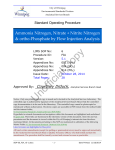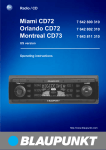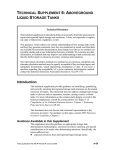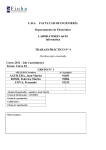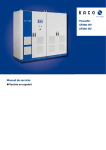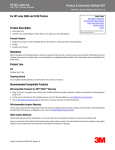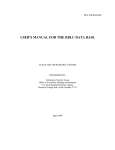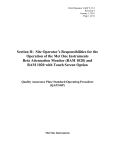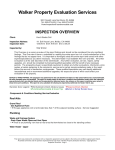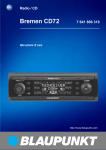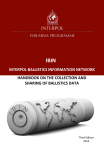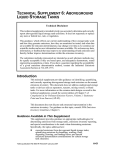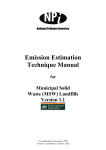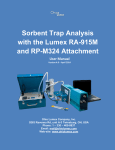Download 10_PetroRefine
Transcript
California Air Resources Board Instructional Guidance for Mandatory GHG Emissions Reporting December 2008 CHAPTER 10: PETROLEUM REFINERIES (Guidance for Regulation Section 95113) As listed in section 95113(a) of the regulation, the emissions data report for a petroleum refinery must include the following information as applicable: 1. Stationary combustion CO2 emissions by fuel type 2. Stationary combustion CH4 and N2O emissions by fuel type 3. Consumption data for fuels and feedstocks 4. Hydrogen production plant emissions of CO2, CH4, and N2O 5. Specified process emissions 6. Specified fugitive emissions 7. Flaring emissions 8. Emissions from electricity generating units 9. Emissions from co-generation facilities 10. Indirect energy purchases Calculation methods for each of these reporting requirements are discussed in this chapter. Note that in addition to referring to the common methodologies section of the regulation (section 95125), you will find general guidance on applicable methods in Chapter 13 of this document. Information specific to refineries is included here. 10.1 Stationary Combustion Emissions As indicated by the regulation’s general requirements (section 95103(a)(2)), the operator needs to calculate and report emissions for each GHG separately for each fuel type used (except where a CEMS is deployed, discussed below). Thus, in compiling and reporting stationary combustion emissions you will be effectively populating a matrix that looks something like the one below. The fuels you combust may be different than those shown in the Table below, of course. Table 10.1 Stationary Combustion GHG Emissions Fuel Refinery fuel gas Natural Gas Associated Gas Diesel Fuel Residual Fuel Propane CNG Gasoline Kerosene Naphtha CEMS (fuel mixtures) CO2 CH4 N2O n/a n/a The purpose of this chapter is to provide guidance on the requirements of section 95113 of the mandatory GHG reporting regulation. As described more specifically in Chapter 1 of this document, this guidance does not add to, substitute for, or amend the regulatory requirements as written in these or other sections of the regulation [Subchapter 10, Article 2, sections 95100 to 95133, title 17, California Code of Regulations]. 10-1 Refineries California Air Resources Board Instructional Guidance for Mandatory GHG Emissions Reporting December 2008 10.1.1 Reporting Stationary Combustion CO2 emissions Using CEMS In most cases CO2 emissions from stationary combustion will be calculated using methods that are based on the type of fuel combusted. The one exception is when a Continuous Emission Monitoring System (CEMS) is used to measure CO2 emissions. CEMS may be used to measure and report stationary combustion emissions from single or multiple combustion sources. New CEMS must be installed and operated according to the requirements of 40 CFR Part 75, except that the ARB regulation does not trigger a reporting requirement to the U.S. EPA. CO2 concentrations (rather than O2) and flue gas flow measurements should be used to determine hourly CO2 mass emissions for any new CEMS system, per section 95125(g)(7). Operators must also measure and report fuel consumption that results in GHG emissions. When you use a CEMS to determine GHG emissions resulting from the combustion of a fossil fuel mixture, it will not be possible to separately report CO2 emissions for each fuel contained in the mixture. The CEMS data are instead used to report CO2 emissions from combustion of the mixture. See the guidance for section 95125(g), found in section 13.7 of this document, for additional direction on CEMS. 10.1.2 Options for Calculating and Reporting Refinery Fuel Gas CO2 Combustion Emissions For most California refineries, refinery fuel gas (RFG) represents a significant fraction of the fuel that is combusted during refining processes. There also may be significant compositional variation among multiple fuel gas systems within a refinery. It is essential that fuel characteristics affecting GHG emissions be accurately determined. The reporting regulation is designed to provide high resolution data to quantify CO2 emission from this very important source. Several quantification approaches are available to provide operators with flexibility in exactly how to quantify refinery fuel gas emissions, and these are discussed below. At most refineries, emissions must be determined daily for each RFG system. In cases where multiple RFG systems are mixed and homogenized prior to combustion, it may be more appropriate to determine the carbon content of the mixture, rather than each system individually. The most important consideration is to ensure that the carbon content of all RFG combusted is accurately quantified. There are three general procedural approaches for calculating CO2 emissions resulting from the combustion of refinery fuel gas: 10.1.2.1 CEMS (section 95125(g)): The operator may use a CEMS to quantify CO2 emissions from one or more refinery fuel gas systems. Refer to section 95125(g) of the regulation and section 13.7 of this guidance documentation for specifics concerning CEMS installation, operation and emissions calculation. 10-2 Refineries California Air Resources Board Instructional Guidance for Mandatory GHG Emissions Reporting December 2008 10.1.2.2 Carbon content testing using on-line instrumentation or discrete sample laboratory analysis (section 95125(d)(3)(A)): The operator may use on-line instrumentation (e.g., a gas chromatograph) to determine fuel gas carbon content. An important consideration in evaluating any online compositional analysis method is that the instrumentation and analytical methodology used provide a complete characterization of all major species present in the refinery fuel gas system. In practice, the operator should ensure good quality data is gathered on ≥95 percent of the mass of hydrocarbons present in each RFG system where on-line instrumentation is used. ARB staff recommends that instrumentation be operated, maintained, and calibrated according to original equipment manufacturer (OEM) specifications, and located appropriately in order to obtain a representative sample of the RFG system in question. For each RFG system where on-line instrumentation is used, the operator must determine carbon content and fuel molecular weight at least once every eight hours that RFG from the system is combusted. Measurements should be taken at approximately the same relative period (beginning, middle, or end) during each 8 hour period--or at times during each 8 hour window appropriate to provide for representative sampling. For each analysis, the operator will also need to calculate refinery fuel gas molecular weight (kg fuel/kg-mole) using the data from the on-line instrumentation. To calculate daily CO2 emissions, the current day carbon content values (kg C/kg fuel) should be averaged to calculate daily average carbon content. Similarly, the fuel molecular weight determinations should be averaged. These daily average carbon content and fuel molecular values are then applied to the equation found in section 95125(d)(3)(A) along with the amount of RFG combusted, to calculate daily CO 2 emissions. Daily emissions are then summed to calculate annual emissions from each RFG system. 10.1.2.3 System specific CO2 emission factor (section 95125(e)): This third approach requires you to use an on-line high heat value (HHV) analyzer. HHV data and a daily carbon content determination are used to derive a daily refinery fuel system specific CO2 emission factor. This emission factor is then used with a daily average RFG system HHV value (from the on-line analyzer) to calculate CO2 emissions. 1. Calculate a RFG system specific daily emissions factor: You need to determine the carbon content and HHV for the RFG system in order to calculate a CO2 emission factor. To do this, once per day, determine the carbon content (kg C/kg fuel), molecular weight (kg fuel/kg-mole) and the HHV (Btu/scf) of the RFG system. Carbon content and fuel molecular weight are measured by drawing a representative RFG sample and performing a carbon analysis. Carbon content and molecular weight may also be determined using an on-line instrument. High heating value is determined either using data from the carbon analysis or from an on-line HHV analyzer. When using data from an on-line HHV analyzer, the operator uses either the hourly average HHV value coinciding with the hour in which the carbon content determination is made, or the hour in which the sample was collected for analysis. A daily emission factor (metric tonnes 10-3 Refineries California Air Resources Board Instructional Guidance for Mandatory GHG Emissions Reporting December 2008 CO2/MMBtu) is then calculated using the equation found in section 95125(e)(3). The operator should ensure that a representative sample is drawn for carbon analysis, the HHV analyzer is properly installed in an appropriate location, the carbon content analysis accurately characterizes the fuel, and sampling is performed under conditions representative of prevailing operational parameters. 2. Calculate CO2 emissions: Once you have determined a daily CO2 EF for your RFG system, daily CO2 emissions are calculated using the daily average RFG HHV derived from the on-line continuous HHV analyzer. Use of a daily average HHV is designed to integrate daily variations in RFG heating value (and indirectly carbon content). This calculation is accomplished using the formula found in section 95125(e)(4). RFG CO2 emissions for all RFG systems are then summed to calculate facility RFG CO2 emissions. Exception for Small Refineries. Refiners that qualify as “small” refiners under California statutes may calculate CO2 emissions from refinery fuel gas combustion on a weekly basis, rather than daily. See Title 13, California Code of Regulations, Section 22609(a)(32) to determine whether your facility is “small.” 10.1.3 Calculating Natural Gas and Associated Gas CO2 Combustion Emissions (section 95125(c) or (d)) There are several steps required to calculate stationary combustion CO2 emissions from natural gas and associated gas. 1. Determine fuel HHV – The operator needs to know the HHV of the natural gas or associated gas in order to determine which method to use to calculate CO2 stationary emissions from these two fuels. HHV may be measured either by the facility operator or by the fuel supplier. HHV may be determined by using the ASTM methods listed in section 95125(c)(1)(B), or by using on-line instrumentation. 2. Converting low heat value (LHV) to HHV - If you currently have installed an online analyzer that measures only LHV, you will need to convert LHV to HHV using the approach shown in section 95125(c)(1)(C) where HHV = LHV x CF. If the fuel in question is natural gas, you should use a conversion factor (CF) of 1.11. If the fuel is a mixture containing refinery fuel gas, simply derive a weekly average fuel system specific CF where CF = HHV/LHV. The weekly HHV may be derived from either from the daily HHV calculated as part of the daily carbon content determination or from on-line instrumentation. 3. Next you will choose a CO2 emission calculation method based on fuel HHV value. If the HHV of your natural gas, associated gas or mixture is ≥975 Btu/scf but ≤1100 Btu/scf you should determine HHV on a monthly basis. The monthly HHV value is then used with an EF (kg CO2/MMBtu) to calculate fuel CO2 emissions (section 95125(c)(1)). The applicable EF value can be found in Table 4 of regulation Appendix A. Choose the EF which corresponds to the correct 10-4 Refineries California Air Resources Board Instructional Guidance for Mandatory GHG Emissions Reporting December 2008 HHV range of the natural gas or associated gas you combusted during the month in question. 4. If the HHV of your fuel is either less than 975 Btu/scf or greater than 1100 Btu/scf either you or your fuel supplier must determine fuel carbon content a minimum of once per month. CO2 emissions are then calculated using the formula found in section 95125(d)(3). 10.1.4 Calculating CO2 combustion emissions from Fuel Mixtures (section 95125(f)) There are two critical requirements that must be met to ensure valid emissions estimation whenever two or more fuels are mixed prior to combustion. First, the amount of each fuel combusted must be determined accurately. Secondly, the fuel combusted must be adequately characterized. Thus you must determine the appropriate fuel characteristics (HHV and/or carbon content) of either the fuel mixture or every individual fuel contained in the mixture. The operator may choose to use a CEMS to determine fuel mixture CO2 emissions, in which case fuel characterization is not required. The operator will still need to measure consumption for each fuel, however. If the operator mixes refinery fuel gas with natural gas or another fuel prior to combustion, the resulting fuel mixture is subject to the more stringent refinery fuel gas requirements concerning sampling frequency and emissions determination. In this case section 95125(f) refers you to section 95125(d)(3)(A) or 95125(e). 10.1.5 Options for Calculating CO2 Combustion Emissions from Other Fuels (section 95125(a), (c), or (d)) The methods described in sections 95125(a), (c) and (d) of the regulation are applied to the more common fuels, where composition, heating value, carbon content and thus CO2 combustion emissions are well characterized and exhibit little variability. In addition to CEMS (discussed above), the regulation provides three alternatives for determining CO2 stationary combustion emissions for these fuels: 10.1.5.1 Default CO2 emission factor and default heat content (section 95125(a)): Find the fuel in Table 4 of regulation Appendix A. Use the default HHV and CO2 emission factor values for the fuel along with fuel consumption data (mass or volume/year) to calculate stationary combustion emissions for this fuel. 10.1.5.2 Measured HHV and default CO2 emission factors (section 95125(c)): You may also choose to use measured (rather than a default value) HHV with a default CO2 emission factor. If you choose to determine fuel HHV, you must comply with the requirements of section 95125(c) and related sections dealing with parameters such as sampling frequency and analysis methods. 10.1.5.3 Measured carbon content (section 95125(d)): Finally, you may choose to measure fuel carbon content and calculate fuel stationary combustion emissions using the appropriate solid, liquid, or gaseous fuel formula and ASTM method found in section 95125(d). ARB staff recommends you choose an 10-5 Refineries California Air Resources Board Instructional Guidance for Mandatory GHG Emissions Reporting December 2008 analytical method that provides data for ≥95 percent of the carbon in the fuel. For all fuels other than refinery fuel gas, carbon content should be measured monthly. Careful consideration of default values. In practice, when should you determine fuel HHV and/or carbon content rather than use default values? If you have concerns or questions concerning the accuracy of default values it would be appropriate to investigate in more detail which approach is suitable to ensure an accurate accounting. As an example, if you are using headspace gas as a fuel or feedstock and are presently measuring only bulk liquid composition, you should examine the appropriateness of this approach. How closely does the liquid analysis approximate the composition of the actual fuel or feedstock, and is the measured HHV significantly different from the default value? In this case, analysis of both phases should answer the question. When you are presented with alternative approaches, choose the method that ensures the integrity of your emissions report, not the simply the easiest or least expensive. 10.1.6 Calculating CO2 Combustion Emissions from Low Btu Gases (section 95113(a)(1)(E)) Section 95113(a)(1)(E) details stationary combustion CO2 emission calculations for low Btu gases and flexigas. Pressure swing absorption off-gas, vapor recovery gases, and asphalt tank headspace gases are examples of low Btu gases. If you have questions as to whether a process gas that you generate might fall into this category, ARB encourages you to discuss the issue with staff. Flexigas is formed when hydrocarbons are thermally cracked in a flexicoker to produce coke products. Usually low Btu gases are either used as a supplemental fuel that is mixed with a fuel of higher Btu content and combusted as part of a fuel mixture, or destroyed in a flare or other destruction device such as a thermal oxidizer. Other than inclusion in CEMS estimates, low Btu gas stationary combustion CO2 emissions are determined depending upon their use: 10.1.6.1 Combustion of low Btu gases as a fuel: If you are mixing a low Btu gas to supplement another fuel, consult sections 95125(f)(1)(A) and (C). If you are mixing a low Btu gas with refinery fuel gas, the more stringent RFG requirements apply to the resulting mixture. If you mix a low Btu gas with natural gas, the HHV of the resulting mixture determines which emissions calculation method you should use, just as is the case with natural gas. If the HHV of the natural gas/low Btu gas mixture falls in the 975 -1100 Btu range, then you should determine mixture HHV monthly, use the appropriate default CO2 emission factor from Table 4 of regulation Appendix A, and calculate emissions using the formula in section 95125(c). If the HHV of the mixture is above or below this range, you must measure the carbon content of the mixture monthly and use the formula in section 95125(d)(3) to calculate CO2 emissions. 10-6 Refineries California Air Resources Board Instructional Guidance for Mandatory GHG Emissions Reporting December 2008 10.1.6.2 Destruction of low Btu gas in a flare or other destruction device (section 95113(d)) The operator should choose the appropriate emissions calculation method based on the disposition of the low gas stream. Choose the applicable option below: a) Your Low Btu gas is sent to a flare or flares and you report these flare emissions to your local AQMD/APCD: In this case refer to section 95113(d)(2). Choose the method you use based on your Air District reporting requirements. For a more detailed discussion see the Flare/Control Device (section 95113(d) discussion below. b) Your Low Btu gas is destroyed in a destruction device such as a thermal oxidizer and emissions are not reported to the local AQMD/APCD: In this case refer to section 95113(d)(3). You must determine carbon content and molecular weight of the low Btu gas quarterly and compute an annual average. You must also determine the volume of low Btu gas destroyed annually (± 7.5 percent) and use the equation in section 95113(d)(3) to calculate annual CO 2 combustion emissions. 10.1.7 Calculating Stationary Combustion CH4 and N2O emissions (section 95125(b)) CH4 and N2O emissions resulting from fuel combustion represent a small fraction of fuel combustion related GHG emissions. While CH4 and N2O emissions are strongly dependent on combustion technology, calculation methods are fuel specific and based on fuel HHV. You should choose the most appropriate of the following three methods for calculating CH4 and N2O stationary combustion emissions. 10.1.7.1 Source Testing (section 95125(b)(4)): The operator may elect to conduct source testing to determine fuel and combustion specific emissions factors (EFs) for CH4 and/or N2O. The source test plan you use must be approved by ARB and repeated at least annually under the supervision of ARB or the local air district. EFs should be expressed in terms of grams of CH4 or Emission factors derived from source testing are specific to fuel and combustion grams of N2O per MMBtu. Additionally, technology. If you conduct source testing on the HHV of the fuel in question should be a steam boiler combusting refinery fuel gas, measured at the time of the source test. for example, the derived CH4 and N2O EFs Use the measured fuel HHV rather than a should be used only when calculating CH4 and default value, and the methodology N2O emissions from similar boilers combusting specified in section 95125(b)(2). Source refinery fuel gas. testing is addressed in more detail in Appendix B of this guidance document. 10.1.7.2 Measured HHV and a default emission factor: Use the method found in section 95125(b)(2) in situations where the HHV of the fuel in question is measured. 10.1.7.3 Default fuel HHV and emissions factors: In the case where the fuel HHV is not measured, you may use default HHV and EF values. Default HHV and EF values for CH4 and N2O are found in Table 4 of regulation 10-7 Refineries California Air Resources Board Instructional Guidance for Mandatory GHG Emissions Reporting December 2008 Appendix A. For refinery fuel gas use the values listed for “still gas.” Use the equation found in section 95125(b)(3). 10.1.8 Calculating CH4 and N2O combustion emissions from Derived Gases The emission factors for derived gases, found in Table 6 of regulation Appendix A, are applicable for species such flexigas, PSA off-gas, and low Btu gases in general. 10.2 Fuel and Feedstock Consumption The operator is required to report both fuel and feedstock consumption as directed in section 95113(a)(3). You should report in the units indicated the consumption of all fuels combusted at the facility, and all feedstocks involved in processes that are used to calculate GHG emissions. In addition, section 95103(a)(2) requires you to report fuel consumption for each process unit or group of units where fuel use is separately metered. 10.3 Reporting Hydrogen Production Plant Emissions Refer to Chapter 11 of this document for guidance on reporting emissions from hydrogen production facilities. Hydrogen plants associated with petroleum refineries may be owned and operated by the refinery, or by another entity contracted to provide hydrogen for the refinery. Reporting responsibility rests on the entity with operational control of the hydrogen plant, as discussed in Chapter 2. 10.4 Refinery Process Emissions At most refineries the major source of process emissions of GHGs is catalyst regeneration. Process emissions also are generated from process vents, asphalt blowing, and sulfur recovery. Using CEMS. Just as the processes that generate GHGs in a refinery differ, methods to calculate GHG emissions are process specific. However, use of a CO2 CEMS to measure process GHG emissions is an option. As is the case with CEMS used with stationary combustion emissions, process CEMS must be installed and operated according to requirements found in 40 CFR Part 75. (This does not mean you are required to report CEMS CO2 emissions to U.S. EPA.) 10.4.1 Calculating CO2 Emissions from Catalyst Regeneration Refinery catalyst may be regenerated in a number of different manners. The operator should choose the most appropriate method in section 95113(b)(1) and (2), described below, based on the manner in which catalyst is regenerated. Table 10.2 summarizes the needed information. 10-8 Refineries California Air Resources Board Instructional Guidance for Mandatory GHG Emissions Reporting December 2008 10.4.1.1 Reporting Fluid Catalytic Cracking Unit (FCCU) process CO2 emissions (section 95113(b)(1)): If you have a Fluid Catalytic Cracking Unit (FCCU), the GHG emissions quantification method you will use is based on the calculation of hourly coke burn rate in the catalyst regeneration unit. Here are the steps involved: 1. Coke burn rate is calculated on an hourly basis using the methodology specified by the U.S. EPA in 40 CFR Part 63 (National Emission Standards for Hazardous Air Pollutants: Petroleum Refineries). Coke burn rate input parameters are derived from FCCU control room instrumentation. See the first equation in 95113(b)(A) for specifics. You should use the equation for the calculation of Qr (the volumetric flow rate of exhaust gas before entering the emission control system) which is provided in this section. Calculation of Qr is also based on 40 CFR Part 63 guidelines. 2. You will then calculate a daily average coke burn rate expressed in kg/day. 3. Next, you need to determine the carbon fraction in the coke burned. That is, what fraction of the coke contained on spent catalyst is carbon? As an example, if based on analysis of FCCU catalyst withdrawn from an appropriate sampling location you determine that 95 percent of the mass on the spent catalyst is carbon, carbon content would be expressed as CF = 0.95. Assuring Carbon Fraction Accuracy. Note that the regulation does not specify a frequency or methodology for the determination of the variable carbon fraction. As FCCU CO2 emissions may represent a significant fraction of your refinery GHG emissions, you will want to ensure that the methodology you use to determine your spent and regenerated catalyst carbon fraction is accurate. ARB staff recommends that you also examine the temporal variability of carbon fraction and choose an analysis frequency that is appropriate. Some of the issues you should consider: at what rate does the carbon fraction on spent and regenerated catalyst change; are the changes linear; are there periodic operational changes (e.g. addition of new catalyst) that may result in step changes in carbon fraction values; what changes in operating conditions should trigger carbon fraction determination? It is recommended that you develop a sound methodology and retain all data and experimental procedure documentation. Some up-front sampling and/or data analysis will ensure that your FCCU CO2 emissions are reported accurately, minimize lab and personnel costs, and facilitate verification. Material balance based determinations of these variables may be appropriate but this approach should be well documented and supported. Calculate CO2 emissions from your FCCU using the equation found in section 95113(b)(1)(C) and shown below. See Table 10.4.1.1 for a description of the required variables. n CO 2 = ∑ CR d ∗ CF ∗ 3.664 ∗ 0.001 1 10-9 Refineries California Air Resources Board Instructional Guidance for Mandatory GHG Emissions Reporting December 2008 Table 10.4.1.1 FCCU CO2 Process Emissions Required Data n – number of days of operation CRd – daily average coke burn rate CF – carbon fraction in coke burned conversion factor – carbon to carbon dioxide Conversion factor kg to metric tonnes Units/Value unitless Data Source Operator determined kg/day operator measured unitless operator determined 3.664 supplied 0.001 supplied 10.4.1.2 Calculating Other Catalyst Regeneration Process Emissions (section 95113(b)(2)): Methods for GHG emissions determination for alternate catalyst regeneration processes are presented in section 95113(b)(2) of the regulation and summarized below. a) Periodic Catalyst Regeneration Process Emissions. If you regenerate catalyst periodically you should refer to the methodology found in section 95113(b)(2)(A). You will determine CO2 emissions occurring during each regeneration cycle and sum to calculate annual emissions. In this case you will need to know the mass of catalyst regenerated during each regeneration cycle. You will also need to determine The regulation allows you to use a default the weight fraction of carbon on value of zero for the weight fraction of both the spent catalyst prior to carbon on your regenerated catalyst. Keep regeneration and on the in mind that using this default value may regenerated catalyst. As is the result in an overestimation of your CO2 case with FCCU catalyst emissions, and thus staff recommends that regeneration, the regulation does this variable be measured periodically not specify an analytical during the working lifetime of the catalyst. methodology or measurement frequency. Again, staff recommends that you choose an appropriate method and sampling frequency to ensure that you accurately characterize emissions from this source. The required variables and equation are found immediately below. 10-10 Refineries California Air Resources Board Instructional Guidance for Mandatory GHG Emissions Reporting December 2008 Table 10.4.1.2a Periodic Catalyst Regeneration CO2 Process Emissions Required Data n – number of days of operation CRR – mass of catalyst regenerated CFspent – weight fraction carbon on spent catalyst CFregen – weight fraction carbon on regenerated catalyst Conversion factor – carbon to carbon dioxide Conversion factor – kg to metric tonnes Units/Value unitless Data Source operator determined kg/regeneration cycle operator determined unitless operator determined unitless (default = 0) operator determined 3.664 supplied 0.001 supplied CO 2 = ∑ CRR ∗ (CFspent − CFregen ) ∗ 3.664 ∗ 0.001 n 1 b) Reporting Continuous Catalyst Regeneration Process Emissions. If you regenerate catalyst continually in an operation other than an FCCU you should use the method found in section 95113(b)(2)(B). As is the case with periodic catalyst regeneration discussed above, you need to determine carbon fraction on both spent and regenerated catalyst. Choose an appropriate sampling location, analytical methodology and sampling frequency. You will also need to determine the average catalyst regeneration rate and the time the regenerator was operational. These variables (shown in the Table below) are entered into the equation found in section 95113(b)(2)(B) to calculate annual CO2 emissions. Table 10.4.1.2b Continuous Catalyst Regeneration - CO2 Process Emissions Required Data CCirc - average catalyst regeneration rate CFspent – weight fraction carbon on spent catalyst CFregen – weight fraction carbon on regenerated catalyst H – hours regenerator operated annually Conversion factor – carbon to carbon dioxide Units/Value tonnes/hr Data Source Operator determined unitless operator determined unitless (default = 0) operator determined hours/year operator determined 3.664 supplied CO 2 = CCirc ∗ (CFspent − CFregen ) ∗ H ∗ 3.664 10-11 Refineries California Air Resources Board Instructional Guidance for Mandatory GHG Emissions Reporting December 2008 10.4.2 Calculating Process Vent Emissions If facility equipment continuously or periodically discharges a gas stream to the atmosphere directly or after being routed to a control device and you do not report these process vent emissions elsewhere in your GHG report (e.g. flare or other control device emissions, refinery fuel gas combustion, etc), you must report CO2, CH4 and N2O emissions from process vents. It is important to avoid double counting of process vent emissions. Additionally, if you transfer a process vent stream to a third-party facility for processing, the responsibility for reporting resulting emissions is also transferred to that third-party facility. To quantify process vent emissions you need to measure the vent release rate and duration of venting to determine the volume of gas emitted. You must also measure the molar fraction of each GHG (CO2, CH4, and N2O) in the vent gas stream. Especially in the case of hydrogen plant process vent emissions, measurement of flow rate and gas composition is difficult at best. ARB staff recommends that you consult AQMD/APCD regulations for additional guidance. For example, South Coast Air Quality Management District Rule 1189 – Emissions from Hydrogen Plant Process Vents, provides valuable direction for sampling and analyzing these process vent streams. Table 10.4.2 Process Vent Emissions - CO2, CH4, and N2O Required Data VR – vent rate Fx – molar fraction of X in vent gas stream (X = CO2, CH4, or N2O) MWx – molecular weight of X MVC – molar volume conversion VT – time duration of venting n – number of ventings CF – kg to metric tonnes Units/Value scf/unit time kg/kg-mole choose MVC for 20°C or 60°F time number 0.001 Data Source operator measured supplied supplied operator determined operator determined supplied n E x = ∑ VR ∗ Fx ∗ MW x ÷ MVC ∗ VT ∗ 0.001 1 10.4.3 Calculating Asphalt Production Emissions If you conduct asphalt blowing operations at your facility you are required to report CO2 and CH4 emissions that result from control measures. The assumption is that emissions from asphalt blowing operations are directed to a destruction device such as a flare or incinerator for control. It is important not to double count these emissions. If asphalt plant blowing emissions are sent to a flare and you report emissions from this flare to your local AQMD/APCD you will report GHG emissions using the methodology in regulation section 95113(d), as discussed in section 10.6.1 of this chapter. They would not be calculated using the following methodology. 10-12 Refineries California Air Resources Board Instructional Guidance for Mandatory GHG Emissions Reporting December 2008 If you control asphalt blowing emissions using a destruction device such as an incinerator, you should use the methodology found in section 95113(b)(4). You will calculate CH4 emissions resulting from the incomplete combustion of asphalt blowing emissions as well as combustion/destruction related CO2 emissions. In both cases you need to know the mass of asphalt blown (103 bbl/year) annually. To calculate CH4 emissions from the mass of asphalt blown annually, an emission factor (volume of methane released per thousand barrels of blown asphalt) of 2,555 scf CH4/103 bbl, and an assumed destruction efficiency of 98 percent are used in the first equation found in section 95113(b)(4)(A) to calculate annual methane emissions. These same inputs are used to calculate CO2 combustion emissions using the second equation in section 95113(b)(4)(A). In this case a conversion factor (2.743) is used to convert from CH4 to CO2. Table 10.4.3a Asphalt Blowing Operations - CO2 Process Emissions Required Data MA – mass of asphalt blown EF – methane emissions MWCH4 – methane molecular weight MVC – molar volume conversion DE – methane destruction efficiency CF – kg to metric tonnes Units/Value 103 bbl/yr 2,555 scf CH4/103 bbl 16.04 kg/kg-mole Data Source operator measured supplied supplied choose MVC for 20°C or 60°F supplied 98% (expressed as 0.98) supplied 0.001 supplied CH4 = (M A ∗ EF ∗ MWCH4 ÷ MVC)(1 − DE ) ∗ 0.001 Table 10.4.3b Asphalt Blowing Operations - CH4 Process Emissions Required Data MA – mass of asphalt blown EF – methane emissions MWCH4 – methane molecular weight MVC – molar volume conversion DE – methane destruction efficiency CF – CH4 to CO2 CF – kg to metric tonnes Units/Value 103 bbl/yr 2,555 scf CH4/103 bbl 16.04 kg/kg-mole Data Source operator measured supplied supplied choose MVC for 20°C or 60°F supplied 98% (expressed as 0.98) supplied 2.743 0.001 supplied supplied CO 2 = (M A ∗ EF ∗ MWCH4 ÷ MVC) ∗ DE ∗ 2.743 ∗ 0.001 10.4.4 Reporting Sulfur Recovery Unit Process Emissions Numerous refining processes (e.g. distillation, hydrodesulfurization and catalytic cracking) generate products that require sulfur removal and thus are directed to a sulfur recovery plant. These process streams also contain entrained hydrocarbons that are typically oxidized during the sulfur removal process and subsequently emitted as 10-13 Refineries California Air Resources Board Instructional Guidance for Mandatory GHG Emissions Reporting December 2008 CO2. This section of the regulation (section 95113(b)(5)) is designed to account for these emissions. To calculate CO2 emissions from a sulfur recovery plant you need to know the volume of gas treated annually at your plant. Depending upon the pumping configuration of your sulfur recovery plant, this may require measurement of multiple input stream flows. Make sure that you account for all sour gas streams entering the plant. A default molecular fraction (%) of CO2 in the sour gas treated of 20 percent (expressed as 0.20), may be used to then calculate CO2 emissions as shown in section 95113(b)(5)(A). If you believe that this default value may overestimate or underestimate CO2 emissions, you may submit a request to ARB to conduct source testing for one or more of the sour gas streams entering your sulfur plant. For example, if you have one sour gas stream that has a low carbon content, you may submit a source test plan for that gas stream to ARB for review. If ARB approves your source test plan you will conduct source testing annually, during a period of typical and representative operating conditions and under the supervision of ARB or local AQMD/APCD personnel. For all sour gas streams that you do not source test, you should use the default value of 20 percent. In the case where you do conduct source testing, CO2 emissions for the source tested sour gas stream should be summed with CO2 emissions from all nonsource tested streams and total CO2 emissions related to sulfur recovery reported. Table 10.4.4 Sulfur Recovery Units - CO2 Process Emissions Required Data FR – volumetric flow of acid gas to SRU MWCO2 MVC – molar volume conversion MF – molecular of CO2 in sour gas 0.001 Units/Value metric tonnes/yr Data Source operator measured 44 kg/kg-mole choose MVC for 20°C or 60°F supplied supplied default MF = 20% or operator source test CF – kg to metric tonnes supplied or operator source test derived supplied CO 2 = FR ∗ MWCO2 ÷ MVC ∗ MF ∗ 0.001 10.5 Reporting Fugitive Emissions The reporting regulation requires that the operator report four categories of fugitive emissions –- methane and nitrous oxide from wastewater treatment, methane from oilwater separators, methane from storage tanks, and methane from fugitive equipment. Each of these is discussed below. 10.5.1 Reporting Wastewater Treatment Fugitive Emissions Both methane and nitrous oxide may be emitted during the treatment of refinery wastewater. Microbial production of methane occurs under anoxic conditions and a small fraction of nitrous oxide, an intermediate product in the nitrification/ denitrification cycle, is emitted to the atmosphere. 10-14 Refineries California Air Resources Board Instructional Guidance for Mandatory GHG Emissions Reporting December 2008 10.5.1.1 Wastewater Methane Emissions Before you sample your wastewater streams, the operator should consult Table 12 in Appendix A of the regulation. Based on the specifics of wastewater treatment and discharge at your facility (first two columns of Table 12) you will need to select a methane correction factor (MCF) which is simply the fraction of waste that is treated anaerobically at the facility in question. The Table contains default MCF values both for untreated discharge and six general aerobic and anaerobic treatment situations. Note that methane recovery for anaerobic treatment is not considered here. Therefore if have an enclosed anaerobic treatment facility where methane is captured and not emitted to the atmosphere, you would not be required to report methane emissions here. There are only two characterization categories provided for aerobic treatment facilities -- a well managed system where small amounts of methane may be emitted and an overloaded and not well-managed system. A range of MCF values is listed for these two treatment conditions, 0 – 0.4. If you choose to characterize your treatment facility as well maintained with no significant methane emissions and use a MCF value of zero, you would not be required to report emissions. Once you have evaluated your treatment and chosen an appropriate MCF value, to determine wastewater related emissions you will need to know the volume of wastewater that is discharged annually to your treatment facilities. To calculate methane emissions you will also need to determine the chemical oxidation demand (COD – kg/m3) of the wastewater and any of any sludge that is removed from the treatment facility. You should sample and measure wastewater COD on a quarterly basis. Choose an appropriate sampling location where a representative sample of incoming wastewater composition can be collected, and sample when situations are representative of normal operational conditions. The regulation does not specify a specific method for the determination of wastewater COD. The determination of COD is a common practice. ARBstaff suggests you consult a recognized reference source such as: Standard Methods for Examination of Water and Wastewater, 20th edition Available at: http://www.standardmethods.org/ If you have more than one wastewater treatment facility you will need to determine the COD of wastewater entering each system. The following variables are then used to calculate methane emissions: annual wastewater volume treated, average COD, sludge COD removed, methane generation capacity (0.25 kg CH4/kg COD) and MCF from Table 12. 10-15 Refineries California Air Resources Board Instructional Guidance for Mandatory GHG Emissions Reporting December 2008 Table 10.5.1.1 Fugitive Emissions from Wastewater Treatment - Methane Required Data Q - Volume of wastewater treated CODqave – average of quarterly COD S – COD removed in sludge B – methane generation capacity MCF – methane conversion factor Conversion factor – kg to metric tonnes Units/Value m3/yr Data Source operator measured kg/m3 operator measured kg COD/yr 0.25 kg CH4/kg COD operator measured supplied unit-less 0.001 operator determined from Table 12, regulation Appendix A supplied CH4 = [(Q ∗ COD qave ) − S]∗ B ∗ MCF ∗ 0.001 10.5.1.2 Wastewater Nitrous Oxide emissions: Calculation of nitrous oxide emissions requires that the operator measure the nitrogen content of effluent on a quarterly basis. If you have more than one autonomous wastewater treatment facility, you must determine N2O emissions from each facility. Samples should be collected at a location representative of wastewater entering the facility immediately prior to treatment. Again, the regulation does not specify a method of analysis and staff suggests that you consult with a reference text or contract laboratory. ARB staff suggests that you consult the EPA Clean Water Act Analytical Methods documentation for references (e.g. Method 351.2) concerning the determination of total nitrogen in wastewater. This documentation can be found at the following link: www.epa.gov/waterscience/methods/. Table 10.5.1.2 Fugitive Emissions from Wastewater Treatment - Nitrous Oxide Required Data Q - Volume of wastewater treated N in effluent N2O emission factor CF – kg N2O-N to kg N2O CF – kg to metric tonnes Units/Value m3/yr kg N/m3 - annual average 0.005 kg N2O-N/kg N 1.571 0.001 Data Source operator measured operator measured - quarterly supplied supplied supplied N2 O = Q ∗ Nqave ∗ EFN2O ∗ 1.571∗ 0.001 10.5.2 Reporting Oil-Water Separator Fugitive Emissions Fugitive methane emissions from oil/water separators must also be calculated if you have these devices at your facility and emissions are not diverted to a destruction device. You should first consult Table 13 in regulation Appendix A. Here you will see that for three types of oil/water separators, gravity, dissolved air flotation (DAF), and induced air flotation (IAF), the methane emission factor is zero when these devices are 10-16 Refineries California Air Resources Board Instructional Guidance for Mandatory GHG Emissions Reporting December 2008 connected to a functioning destruction device. If this is the case at your facility, you are not required to report GHG emissions here. The destruction of low Btu gases such as those recovered from an oil/water separator are covered in section 95113(d)(3). Table 13 does provide methane emission factors for gravity, DAF and IAF oil/water separators when they are either covered or uncovered, and not connected to a destruction device. In these cases you will report methane emissions using the method in this section. You need to know the volume of water annually treated by the separator. The volume of treated water is used along with the appropriate oil/water separator EF from Table 13 to calculate methane emissions. A conversion factor of 0.6 is used to convert from nonmethane hydrocarbons to methane. Table 10.5.2 Fugitive Emissions from Oil/water Separators - Methane Required Data EFsep - NMHC emission factor Vwater – volume of water treated annually CFNMHC – NMHC to CH4 conversion factor Conversion factor – kg to metric tonnes Units/Value kg NMHC/m3 m3/year Data Source operator determined from Table 13, regulation Appendix A operator measured unit-less – 0.6 supplied 0.001 supplied CH4 = EFsep ∗ Vwater ∗ CFNMHC ∗ 0.001 10.5.3 Reporting Storage Tanks Fugitive Emissions There are three types of emissions from hydrocarbon storage tanks: working losses, breathing losses and flashing losses. Working losses occur as a result of the filling and emptying processes. Internal headspace gas is expelled and external air is pulled into a storage tank as product enters and exits the tank. Breathing losses as a result of changes in environmental parameters, such as solar and thermal heating and cooling, cause changes in internal liquid and vapor volumes. Ambient winds can also cause tank breathing emissions as they pass the tank exterior. Flashing losses occur when liquid introduced into a tank changes pressure and volatiles contained in the liquid “flash” off. Fugitive tank emissions will be determined using the U.S. EPA TANKS model.1 This model calculates working and breathing VOC emissions. Model generated VOC outputs will converted to methane emissions using a default conversion factor of 0.6 (CH4 = 0.6 * VOC). Alternatively, you may use the results of storage tank headspace analysis to 1 Note that this program was developed by the American Petroleum Institute (API). API retains the copyright and has granted permission for the nonexclusive, noncommercial distribution of this material to governmental and regulatory agencies. TANKS is available for public use but cannot be sold without written permission from API, the U.S. EPA, Midwest Research Institute, and The Pechan-Avanti Group. 10-17 Refineries California Air Resources Board Instructional Guidance for Mandatory GHG Emissions Reporting December 2008 determine a tank specific conversion factor, but it is suggested that you consult ARB staff prior to using this option. The TANKS model is used to calculate VOC emissions from above-ground storage tanks containing crude oil, asphalt, naphtha, and distillate oils. If any of these storage tanks are equipped with vapor recovery technology, vapors are actively collected and emissions are accounted for elsewhere (e.g., flare GHG or refinery fuel gas system reporting), to avoid double-counting you should not report them here. There are several steps required to generate an emission report for your storage tanks: 1. Install TANKS on a suitable computer; 2. Set up a chemical database for crude oil, asphalt, naphtha, and distillate components; 3. Establish your storage tank database; 4. Generate emissions reports for each storage tank; 5. Sum storage tank VOC emissions; 6. Convert VOC emissions to methane emissions using the default factor (0.6). 10.5.3.1 Installing TANKS TANKS is a window based program available at no cost from the US EPA at the following location. The model can be downloaded from www.epa.gov/ttn/chief/software/tanks/index.html. Consult the system requirements link to ensure that the computer on which you plan to install TANKS meets the minimum requirements (operating system, RAM, hard disk space). A user’s manual is available at the following web page. User’s manual: www.epa.gov/ttn/chief/software/tanks/tanks409b/tank4man.pdf While the user manual is 1999 vintage it remains a very useful document. A list of Frequent Asked Questions (FAQ) can be found here: FAQ: www.epa.gov/ttn/chief/faq/tanksfaq.html#1 Another EPA document you may find very helpful is the September 2006 report entitled “Emission Factor Documentation for AP-42, Section 7.1, Organic Liquid Storage Tanks. This report contains a detailed description of the types of storage tanks, perimeter seals, and deck fittings. It is available here: www.epa.gov/ttn/chief/ap42/ch07/bgdocs/b07s01.pdf Another resource is the Santa Barbara County Air Pollution Control District Rule 325, Crude Oil Production and Separation, found at www.arb.ca.gov/DRDB/SB/CURHTML/R325.PDF. Read the Installation Instructions file first and then install TANKS 4.09D on your computer. You will need to uninstall previous versions of TANKS. If you have previous databases you can import them into TANKS 4.09D. See sections 3.4 Using a Previous Database and 6.0 Database Utilities of the Users Manual for instructions. 10-18 Refineries California Air Resources Board 10.5.3.2 Instructional Guidance for Mandatory GHG Emissions Reporting December 2008 Establishing your Chemical Databases The first step in the set-up procedure of the TANKS model should be to establish chemical databases for the types of hydrocarbons for which you will be calculating VOC emissions – crude oil, asphalt, distillates, and naphtha. 1. Crude Oil - the model contains one Chemical Database for crude oil with an RVP of 5. Use this database for your crude oil storage tanks. 2. Distillate oils – in this case you also use the default database contained in the TANKS model. 3. Naphtha – TANKS contains a data base for jet naphtha – use this database. 4. Asphalt – in the case of asphalt products will need to establish a Chemical Database for this petrochemical. To establish a chemical database for asphalt storage tanks: Run TANKS You will first see a screen containing the USEPA Emissions Factor and Inventory Group logo, click in this box or wait approximately five seconds and the screen will advance and display the TANKS Model Notice Box describing the model origin and distribution restrictions. Click OK to advance to the following screen. 10-19 Refineries California Air Resources Board Instructional Guidance for Mandatory GHG Emissions Reporting December 2008 Close the Welcome screen by clicking the cancel option. Next click the Data button on the top menu bar, choose Chemical from the drop-down menu, and then move the cursor to the right to select Edit Database. See the panel below. TANKS will display an established Chemical Database sheet (acetaldehyde). Click the Add New button at the bottom left of this database to display a blank Chemical Database sheet. Fill in this sheet as shown below: 10-20 Refineries California Air Resources Board Instructional Guidance for Mandatory GHG Emissions Reporting December 2008 When you have entered all the data for the Asphalt Chemical Database Save this file. You are now ready to establish your storage tank data base. 10.5.3.3 Establishing your storage tank data base The next step in working with TANKS is to enter descriptive information concerning the storage tank or tanks for which you will be modeling VOC emissions. If you are creating a new tank file, make sure that the Create New Tank Record button is selected, highlight the type of tank, and click the OK button. Make sure that you have selected the correct tank type from the five tank type options list: Horizontal Fixed Roof Tank: Vertical Fixed Roof Tank: Internal Floating Roof Tank: External Floating Roof Tank: Domed External Floating Roof Tank: HFRT VFRT IFRT EFRT DEFRT 10-21 Refineries California Air Resources Board Instructional Guidance for Mandatory GHG Emissions Reporting December 2008 You will then see the following window: Across the top of this screen you will see five tabs: Identification, Physical Characteristics, Site Selection, Tank Contents, and Monthly Calculations. Step through the first three tabs to determine what information you will need to enter. These first three tabs and data requirements for each are discussed briefly below. Consult the User’s Guide for a more detailed discussion. Identification Tab. The Identification Tab is the same for all types of storage tanks. Identification Tab: enter data for each of the five fields on this page. Identification No: Description: State: City: give each tank a unique ID name. This will be the name that TANKS assigns to this Tank Record. Thus it must be unique and you should maintain a master list to aid in identification when you edit each tank profile and generate your emissions report. enter a brief description of each tank. This will provide you with additional information to aid in tank identification. select California from the pull down menu accessed by clicking on the down arrow select the nearest city to the location of the tank. Note that for both Los Angeles and San Francisco, there are two choices, denoted by the suffixes AP and C.O. AP is airport and C.O. is “City Of”. 10-22 Refineries California Air Resources Board Instructional Guidance for Mandatory GHG Emissions Reporting December 2008 If you wish to review or edit an existing storage tank record select Open an Existing Tank Record, highlighting the tank record you wish to edit, and clicking OK. Physical Characteristics Tab. The data you will enter differs depending upon the type of storage tank record that you are establishing. Below are screen shots for the Physical Characteristics data requirements for each of the five tank types. 10-23 Refineries California Air Resources Board Instructional Guidance for Mandatory GHG Emissions Reporting December 2008 Section 4.0 of the User’s Guide, Entering Tank Data, steps through the data entry process for each of the tank types. Note that in the case of a VFRT where the tank is heated, when you enter data on the Tank Contents tab you are required to enter the Average, Maximum and Minimum Liquid Surface Temperature and the Bulk Liquid Temperature. 10-24 Refineries California Air Resources Board Instructional Guidance for Mandatory GHG Emissions Reporting December 2008 Site Selection Tab. Use the pull-down menu on the Nearest Major City Tab to choose the location most appropriate for your storage tank. Note that major metropolitan areas such as San Francisco and Los Angeles list two locations suffixed with AP (airport) or C.O. (City of). Tank Contents Tab. Use this Tab to designate the contents of each of the storage tanks. Use the following selection to set up storage tank contents files for storage tanks containing crude oil, distillate, asphalt and naphtha. Table 10.5.3.3 Tank Contents Tab Entries Tank Contents Crude oil Asphalt Distillate oil Chemical Category of Liquid Crude oil Petroleum Distillates Petroleum Distillates Single or Multicomponent Liquid single single single Naphtha Petroleum Distillates single Chemical Name Crude oil (RVP 5) Asphalt Distillate Fuel oil no. 2 Jet Naphtha (JP4) Monthly Calculations Tab. Click both the Fill Mixture Names with First Mixture Name and Distribute Throughput buttons. This will populate the monthly contents fields with the contents name and distribute the annual throughput of the storage tank equally across the twelve months of the year. 10.5.3.4 Generating VOC Emissions – Run Report After you have established a Chemical Database for asphalt (if you have asphalt storage tanks at your facility) and your storage tank database, you are ready to generate VOC emission reports. From the tool bar choose Report, and then Annual, and Brief from the pull down menus. You may also select Summary or Detail if you would like to examine the generated data in more detail – this depth of the report which you select will not affect the results. You will then see the following Screen where you will choose the storage tanks for which you generate emission reports. Select tanks in the left column by clicking on them, click on the Select button in the center column and the selected tank will appear in the right column. 10-25 Refineries California Air Resources Board Instructional Guidance for Mandatory GHG Emissions Reporting December 2008 When you have chosen all the storage tanks for which you want to generate emissions reports, click Run Report. The output of the report is then used to calculate methane emissions. Use the Total VOC emissions (TANKS output expressed in lbs VOC) to calculate methane emissions. Multiply this number by either the default conversion factor of 0.6 or the tank specific conversion factor derived from tank headspace analysis to calculate annual methane emissions. Finally, convert from pounds of methane to metric tonnes methane and report this value. You should frequently back-up your TANKS data bases to ensure that all your dataentry work is protected from unforeseen computer problems such as a hard-disk failure. 10.5.4 Reporting Equipment Fugitive Emission - Methane Equipment fugitive methane emissions methods are based upon your local AQMD/APCD Leak Detection and Repair (LDAR) procedures. You will need to extend your LDAR monitoring to all gas service components. This includes all components carrying natural gas, refinery fuel gas, and low Btu gases. All components should be identified as one the following six classification types: value, pump seal, connector, flange, open-ended pipe, and other. For guidance you should consult and use the Component Identification and Counting Methodology found in the following CAPCOA (1999) document: California Implementation Guidelines for Estimating Mass Emissions of Fugitive Hydrocarbon Leaks at Petroleum Facilities, CAPCOA and CARB, 1999. www.arb.ca.gov/fugitive/fugitive.htm 10-26 Refineries California Air Resources Board Instructional Guidance for Mandatory GHG Emissions Reporting December 2008 All gas service components should be screened using a monitoring instrument capable of detecting methane. Screenings should be conducted at the frequency interval required by your local air district. Specific screening procedures and instrument calibration requirements can be found in EPA Reference Method 21 published in 40 CFR 60, Appendix A (EPA Method 21), www.epa.gov/ttn/emc/promgate/m-21.pdf. First identify and screen your gas service components. Component screening values will be used to calculate methane emissions. The CAPCOA document referenced above provides several methods by which VOC emissions may be calculated using component screening values. You will use Method 3: the Correlation Equation Method with modifications as required by the procedures that your local AQMD/APCD has put in place. You will calculate VOC emissions for three categories of components based on the component screening value: 1. Zero components – where the screening value, corrected for background is indistinguishable from zero. 2. Leaking components – components with screening values greater than zero but less than the screening value limit above which the local AQMD/APCD does not allow the use of correlation equations for the calculation of VOC emissions. This upper bound screening value is either 9,999 ppmv or 99,999 ppmv. 3. Pegged components with SVs above the upper SV/correlation equation limit. Each of these three calculation methods is discussed in more detail below: For each of the six Component Types you will find a Default Zero Factor (ZFi0 in kg/hr) in Table 14 of regulation Appendix A. VOC emissions for all zero components are then calculated and summed using the equation found in section 95113(c)(4)(A)(3)(a). Table 10.5.4a Fugitive Equipment VOC Emissions - Zero Components Required Data CCi – number of i components where SV=0 ZFi0 – zero VOC emission factor for component i t = time from last screening Units/Value number Data Source operator determined kg VOC/hour column two - Table 14, regulation Appendix A Operator determined time - hours i = component type, where 1 = valve, 2 = pump seal, 3 = others, 4 = connector, 5 = flange, and 6 = open-ended line 6 E VOC−0 = ∑ CC i ∗ ZFi0 ∗ t i=1 For all leaking components where the component screening value is above zero and below the limit set by your local air district above which correlation equations may not be used for VOC calculation (either 9,999 or 999,999 ppmv) use the equation found in section 95113(c)(4)(A)(3)(b). 10-27 Refineries California Air Resources Board Instructional Guidance for Mandatory GHG Emissions Reporting December 2008 Table 10.5.4b Fugitive Equipment VOC Emissions - Leaking Components (SV > 0 and less than upper bound for use of correlation equation) Required Data σi - correlation equation coefficient for component i SVn – component screening value for component n βi – correlation equation exponent for component type i t = time from last screening Units/Value unitless Data Source column three - Table 14, regulation Appendix A operator determined ppmv unitless column three - Table 14, regulation Appendix A time - hours operator determined If your local air district has set a screening value limit of 9,999 ppmv for the use of correlation equations (SV > 9,999 ppmv is considered pegged) you will use the equation found in section 95113(c)(4)(A)(c) to calculate VOC emissions. 6 E VOCL −C = ∑ i=1 ∑ (σ n n =1 i ) ∗ SVnβi ∗ t Table 10.5.4c Fugitive Equipment VOC Emissions - Pegged Components (SV > 9,999 ppmv) Required Data CCi – number of i components where SV> 9,999 ppmv PFiP-10 – VOC emission factor for component type i pegged over 9,999 ppmv t – time since last screening Units/Value number Data Source operator determined kg VOC/hour column four, Table 14, regulation Appendix A hours operator determined 6 E VOCP−10 = ∑ CC i ∗ PFiP−10 ∗ t i=1 If your local air district has set a screening value limit of 99,999 ppmv for the use of correlation equations (SV > 99,999 ppmv is considered pegged) you will use the equation found in section 95113(c)(4)(A)(d) to calculate VOC emissions. Table 10.5.4d Fugitive Equipment VOC Emissions - Pegged Components (SV > 99,999 ppmv) Required Data CCi – number of i components where SV> 99,999 ppmv PFiP-100 – VOC emission factor for component type i pegged over 99,999 ppmv t – time since last screening Units/Value number Data Source operator determined kg VOC/hour column five, Table 14, regulation Appendix A hours 10-28 operator determined Refineries California Air Resources Board Instructional Guidance for Mandatory GHG Emissions Reporting December 2008 6 E VOCP −100 = ∑ CC i ∗ PFiP −100 ∗ t i=1 After you have calculated VOC emissions for all your zero components, leaking components and pegged components, sum the three to obtain your fugitive equipment VOC emissions. The sum total of VOC emissions is then multiplied by CF, a VOC to CH4 conversion factor and a kg to metric tonnes conversion factor (0.001) to calculate total methane emissions. n CH4 = ∑ (E VOC−0 + E VOC−LC + [E VOCP −10 Lor LE VOCP −100 ]) ⋅ CFVOC ∗ 0.001 1 In most cases you should be able to determine a system specific VOC to methane conversion factor (CF) based on determinations of gas composition and methane content from fuel analysis. In cases where fuel analysis data is available, use the mass CH4/mass fuel ratio to calculate a system specific CF. In cases where representative data is not available you should use a default CF value of 0.6. 10.6 Reporting Emissions from Flares and Other Control Devices section 95113(d) Regulatory methods for the calculation of flaring emissions are based on the reporting requirements of your local air district. You should make sure that stationary combustion emissions of CO2, CH4, and N2O are reported for all flare pilot and purge gas consumed in the flaring process. Consult the previous discussion of stationary combustion emissions for details. 10.6.1 Reporting Flare Emissions Next, based on local air district reporting requirements, the operator will report emissions resulting from the flaring of hydrocarbons routed to your flares. If you are required to report flaring CH4 and NMHC emissions to your local air district (e.g. BAAQMD, Regulation 12, Rule 11) you will report CO2 and CH4 flaring emissions as shown in section 95113(d)(2). First, calculate CO2 emissions resulting from the combustion of both NMHC species and methane contained in hydrocarbon streams routed to flares for destruction. Use the formula found in section 95113(d)(2)(A). The method assumes a carbon fraction of 0.6 for the NMHC species. You should use the flaring destruction efficiency specified by your local air district. 10-29 Refineries California Air Resources Board Instructional Guidance for Mandatory GHG Emissions Reporting December 2008 Table 10.6.1a Flaring Emissions – CO2 and CH4 (Using NMHC and CH4) Required Data CFNMHC – NMHC carbon fraction NMHC – flare NMHC emissions Units/Value unitless CFNMHC = 0.6 kg/day CH4 - flare emissions kg/day FE – flare destruction efficiency CF – methane to carbon dioxide CF – kg to metric tonnes CF – carbon to carbon dioxide percent Data Source supplied operator determined – as per air district reporting requirements operator determined – as per air district reporting requirements specified by local air district 2.743 supplied 0.001 3.664 supplied supplied 365 CO 2 = ∑ [CFNMHC ∗ NMHC ∗ FE ÷ (100 − FE ) ∗ 3.664 + CH 4 ∗ FE ÷ (100 − FE ) ∗ 2.743 ] ∗ 0.001 1 If you are subject to SCAQMD Rule 1118, Control of Emissions from Refinery Flares, you should calculate ROG as specified in Attachment B of Rule 1118 and report flare CO2 emissions as shown in section 95113(d)(2)(B). This document is available at the following link: www.aqmd.gov/rules/reg/reg11/r1118.pdf. The method assumes an ROG carbon fraction of 0.6, and you should use the flare destruction efficiency specified by your local air district. Table 10.6.1b Flaring Emissions – CO2 and CH4 (using ROG) Required Data CFROG – ROG carbon fraction ROG – flare ROG emissions FE – flare destruction efficiency CF – kg to metric tonnes CF – carbon to carbon dioxide Units/Value unitless CFROG = 0.6 kg/day percent 0.001 3.664 Data Source supplied operator determined – as per air district reporting requirements specified by local air district supplied supplied 365 CO 2 = ∑ (CFROG ∗ [ROG ∗ FE ÷ (100 − FE )] ∗ 3.664 ∗ 0.001) 1 Finally if you are not currently required to report flaring emissions to your local air district, you will use a simplified calculation method based on refinery feed throughput. The only variable you will need to supply is refinery through-put in m3/year. 10-30 Refineries California Air Resources Board Instructional Guidance for Mandatory GHG Emissions Reporting December 2008 Table 10.6.1c Flaring Emissions – CO2 (using refinery through-put) Required Data RFT – refinery through-put EFNMHC – NMHC emission factor CFNMHC - NMHC to carbon conversion factor CF – carbon to CO2 CF – kg to metric tonnes Units/Value m3/year 0.002 kg NMHC/m3 unitless 0.6 3.664 0.001 Data Source operator determined supplied supplied supplied supplied CO 2 = RFT ∗ EFNMHC ∗ CFNMHC ∗ 3.664 ∗ 0.001 10.6.2 Reporting Emissions from Destruction Devices Other than Flares This last section of the refining reporting section of the regulation (section 95113) addresses the destruction of hydrocarbons streams, including but not limited to coker flue gas, vapor recovery gases, casing, PSA off-gas and process vent gases. These gases may be destroyed in an incinerator or thermal destruction device, or combusted as a supplemental fuel in heaters, boilers etc. If you use a CO boiler to dispose of hazardous waste, these emissions should be reported here. You should report the resultant CO2 emissions using the method in section 95113(d)(3) if these emissions are not reported elsewhere, such as part of your flaring or stationary combustion emissions. In this case you will need to analyze these gas streams on a quarterly basis – determining both carbon content and molecular weight. You will also need to determine the volume of each gas stream with an accuracy of at least ± 7.5 percent. You should choose analytical methods that provide an accurate measurement of the carbon content of these gas streams. Your choice of analytical methods should be based on the characteristics of the individual gas streams and may be different for different gas streams. CO2 emissions should be calculated for all gas streams destroyed. Table 10.6.2 Emissions from other Control Devices Required Data GVA – volume of gas A destroyed CCA – carbon content of gas A MWA – molecular weight of gas A MVC – molar volume conversion CF – carbon to carbon dioxide CF – kg to metric tonnes Units/Value scf/year Data Source operator determined kg C/kg fuel – annual average of quarterly determinations kg/kg-mole – annual average of quarterly determinations choose MVC for 20°C or 60°F operator determined supplied 3.664 0.001 supplied supplied operator determined CO 2 = GVA ∗ CC A ∗ MW A ∗ 1 ÷ MVC ∗ 3.664 ∗ 0.001 10-31 Refineries California Air Resources Board Instructional Guidance for Mandatory GHG Emissions Reporting December 2008 10.7 Reporting Requirements for Electricity Generation and Cogeneration If electricity generation or cogeneration occurs at your facility (within the same contiguous boundary and under your operational control), emissions from these activities must be included in your emissions data report. If the electricity generating or cogeneration facility has a nameplate generating capacity of 1 MW or more, and its CO2 emissions from electricity generating activities trigger the separate reporting Do you have electricity generation or a threshold of 2,500 metric tonnes, the cogeneration system on site? report must comply with the If your system is at least 1 MW and requirements of regulation sections emitted at least 2.500 MT CO2 from 95111 and 95112, as applicable. electricity generation, refer to the Regulation section 95111 includes the methods provided for the electricity electricity generating facility reporting generation and cogeneration sectors to requirements and is described in Chapter calculate GHG emissions from these 8 of this document, while section 95112 sources. See Chapters 8 and 9. provides the cogeneration system requirements and is covered in Chapter 9. Refer to those sections of the regulation and the associated guidance chapters for more information. If your electricity generating activities are not large enough to trigger these additional reporting requirements, include these emissions in your facility GHG report as additional stationary sources, with emissions calculated specific to fuel type like your other sources. The regulation also includes definitions for “cogeneration facility,” “cogeneration system,” “generating facility,” “generating unit,” and “electricity generating facility,” which may be helpful in evaluating whether these types of activities or units are at the facility. 10.8 Reporting Indirect Energy Usage If you purchase and consume electricity from a retail provider or a facility that you do not own or operate, you need to report the amount of electricity usage and identify the provider. Similarly, if you purchase and consume steam, heat, and/or cooling from a facility you do not own or operate, you need to report this thermal energy use and identify the provider. The methodologies are found in Chapter 13. 10-32 Refineries

































